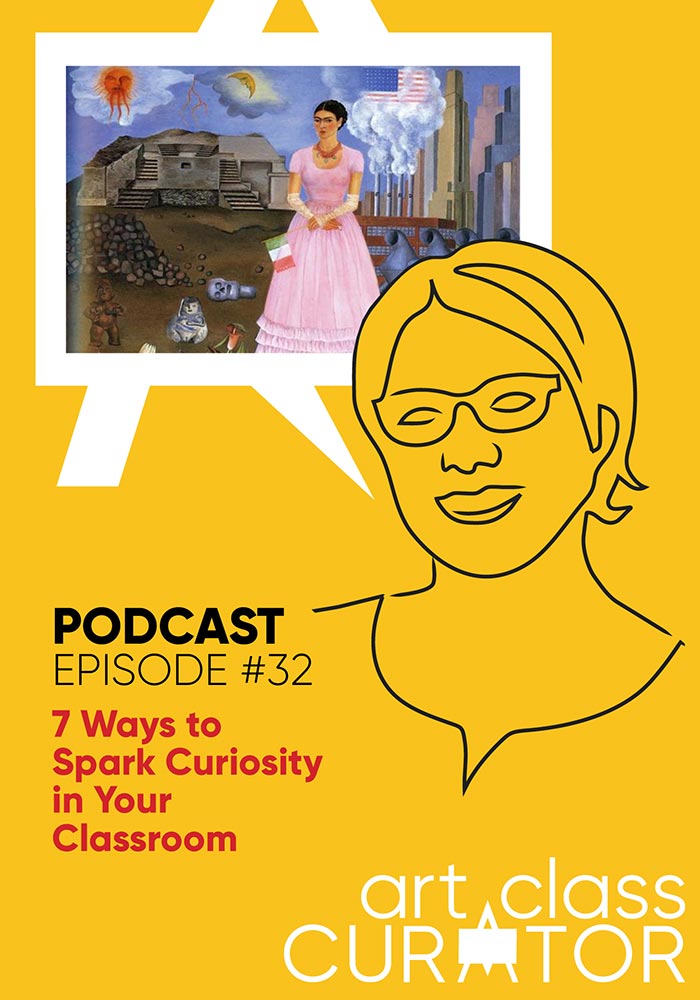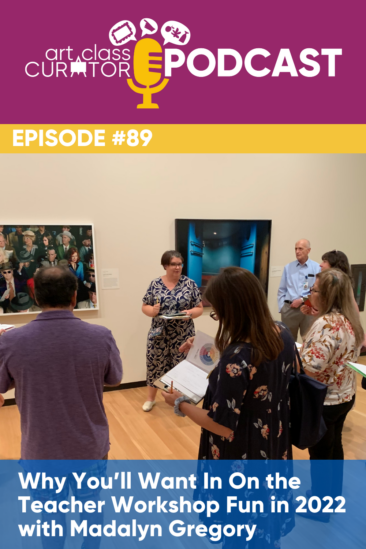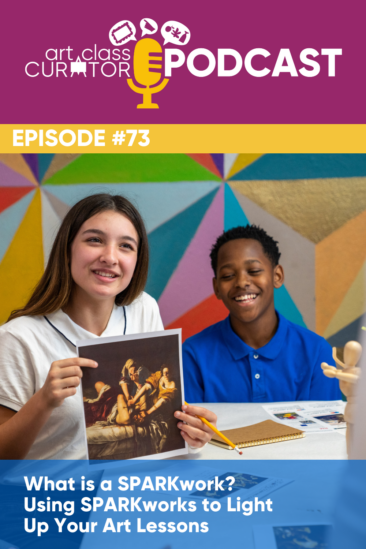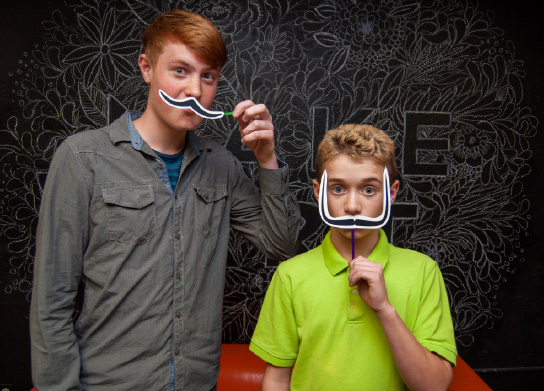In this episode, Cindy discusses how to engage students’ natural born curiosity as well as how to spark curiosity through modeling, exciting artworks, and more.

- Brené Brown, Rising Strong as a Spiritual Practice (affiliate link)
Hello and welcome to the Art Class Curator Podcast. I am Cindy Ingram, your host, and the founder of Art Class Curator and The Curated Connections Library. We’re here to talk about teaching art with purpose and inspiration, from the daily delights of creativity to the messy mishaps that come with being a teacher. Whether you’re driving home from school or cleaning up your classroom for the 15th time today, take a second, take a deep breath, relax those shoulders and let’s get started.
Hello everybody, this is Cindy Ingram, and welcome back to the Art Class Curator podcast. I have recently rebooted the podcast and we have gotten some awesome feedback about the new format, and especially that first episode of Perfection Equals Failure.
So I’m glad that hit a note, or hit a chord with some of you. That really helped get you out of your head a little bit and stop putting so much pressure on yourself. So today, I had to practice what I preach, because my microphone stopped working. And so I was like, “Well, I have this other headset. It’s not as good. It picks up my breathing. It’s going to pick up background noise.” It was like, “Oh.”
And so instead of not doing it because I didn’t have my good mic working, I am just going to record it on this device, and listen to my own advice there. So what I wanted to talk about today is something that came to my mind when I was listening to a book on … I caught myself saying, my husband always makes fun of me for calling them books on tape, because they’re not called books on tape anymore. They’re audio books.
But I’m a child of the eighties and nineties. They’re books on tape. So anyway, I was listening to an audio book, Brené Brown’s … What was it called? Rising Strong as a Spiritual Practice. So I actually haven’t read Rising Strong yet, but I was reading Rising Strong as a Spiritual Practice, and it was basically not really a book. It was a recording of a speech she did in Denver, and it was three or four hours.
So it was a longer thing, but it was really quite good. Anything she does is good, of course. But one of the things that she was talking about was curiosity, and she was specifically talking about curiosity around emotions, and how there are 30 different emotions that humans have, but that most people, they did some studies, that most people are only aware of three of their emotions.
But really, to be an emotionally literate person, you need actually 30. And what she said in relationship to this was that, I don’t know the exact quote, because I already returned the book back to the library, but it was you can’t be curious without knowledge, without information, without knowing enough.
So it’s like we can’t be curious about our emotions if the only emotions we know of are sad, happy and mad. That we need to be knowledgeable in the full scope of what emotions are available before we are allowed to really be curious about it. And that got me thinking, sort of, about our students and about education.
And then just right after that happened, I was talking with my husband, and one of the things that we really enjoy doing is marveling about things. Sort of one of the things I enjoy most in life is just looking at something and trying to figure out how it works. Like watching the Olympics. I marvel about the project management, how they make that whole event happen, how the TV stuff happens, how the scheduling works, how they get everybody there, and where do they stay?
And I was like, stuff like that. And even science. I’ll just be looking at my hand and be like, “God, that’s amazing. My hand doesn’t have any muscles in it. So it’s like, how is my hand able to do this?” And then I think about, well, it’s really my brain telling my hand to do. So anyway, I marvel about all sorts of things.
When I travel, I marvel. I just, I’m always marveling. So anyway, my husband likes to marvel as well, and he was saying the other day, he was like, “You know, it’s really amazing that we breathe in oxygen, something so reactive, and that we just breathe it in.” And I was like, I had no idea what he was talking about. And I was like, “I don’t, I can’t Marvel about that.” I was like, “I really don’t know enough about oxygen to be able to marvel about that.”
And then all of a sudden, it reminded me of what Brené Brown said. It’s like you have to have some sort of base foundational knowledge to be able to be curious. So I couldn’t get curious enough about how oxygen, that’s still, I still don’t know. He didn’t understand that, how I didn’t know. But I wasn’t curious about it because I just had no frame of reference for what oxygen is.
My husband’s a science nerd, loves physics and space and stuff like that. So it made complete sense to him. But to me, I was just like, “I don’t get it.” But that’s what I realize, is that marveling is amazing, but I wouldn’t be able to do it if I didn’t have knowledge about whatever I’m marveling about. Like my hand, the fact that it has no muscles in it, and that your hand is completely run by the muscles in your forearm, and then your muscles is run by your brain.
If I didn’t know that information, I wouldn’t be able to marvel at it. So I think that it really made me think about teaching, and it made me think about providing things, and teaching vocabulary, like the elements of principles and like the basics of art history, that if we don’t teach our students that, then they’re not going to be curious about the art that they’re seeing.
If we don’t teach them how to be curious, and then teaching the information they need in order to be curious, that they’re not going to become curious. So to me, curiosity and wonder about the world is just one of the greatest things there is. I live my life enjoying being curious about everything.
And so, another thing that kind of fits with this, though, is that one of the greatest problems, I feel, that we have as a culture with this new technology of cell phones in our hands and the smartphones, is that we have all the answers. We have so many answers. I can get an answer for anything that I want, and it’s amazing, because I can be curious about something, immediately look it up, and find the answer.
But that, in turn, has made us really uncomfortable with uncertainty, uncomfortable with not knowing the answer. So I think that it’s sort of this weird balance that we have to strike. But now that I know, and that Brené Brown has brought up this, you need information to be curious, it makes me not as worried about that. Because I can be curious about something. I can Google it, and I can get an answer. But then that is only going to feed my curiosity.
It’s not going to kill my curiosity. It’s going to open me up for more things to be curious about. So if I look up, if I were to look up something about how bodies use oxygen, I would have that basis of information. So then I would know, so then I could be curious about more, and then it would lead to more and more questions.
So it made me feel a little bit better about our culture’s sort of inability to deal with uncertainty. I do feel like, though, it is … Curiosity is an uncertain place. So yeah, I think you’re uncertain, it leads to some certainty, but then that leads to even more uncertainty. So I was trying to find the quote, the Brené Brown quote from that book I read, or listened to, and I didn’t find the quote that she was talking about, but I did find this other one from the book Rising Strong.
And it says, “Choosing to be curious is choosing to be vulnerable, because it requires us to surrender to uncertainty,” which I think is really cool. And I think that I love that. So it got me thinking, too, about how else we can foster curiosity in our students and in our classrooms. And it’s interesting, it made me think, too, about that phrase, curiosity killed the cat. In some ways, we, as a culture, I think, learn to stuff down curiosity.
You’re asking too many questions, this and that, and that it’s actually a really amazing thing to be curious, because that’s where problems are solved. That’s where things like smartphones were invented, because someone had the inkling be curious about something. Like, what if we could do this, or that?
So I made a list of some things that I thought of, of ways to foster … Not creativity, curiosity in our students. And the number one thing, not the number one thing, I think they’re all equal, or I didn’t rank them in any way, but the first thing I thought of is this lesson from Brené Brown, which is to teach them things.
So teach them the vocabulary to use when looking at art. Teach them how artists create meaning. Teach them a little bit about art history that makes them want to know more. And I think also giving them the vocabulary will allow them to more deeply understand and then have the ability to be curious about the art.
Related to teaching them things, I also think we only want to give a little bit of information at a time, so we can spark their interest. So, for an example, if you’re looking at Frida Kahlo’s Two Fridas, and the student notice, or just looking at really any Frida painting, but the student might notice that she looks like she’s in pain.
And you say, “Well, you know, actually, Frida was in an accident when she was younger.” And then you can ask, “Well, how do you think that shows in her art?” So that student’s learning that little bit about her being in an accident makes them curious to know more, or makes them curious about how she might’ve felt, makes them look for that in the artwork, and then connects to it in a more deeper way.
So giving little tidbits of information, but not all of the information, will allow students to sort of try to fill in the gaps. Our brains don’t like uncertainty. They don’t like missing pieces. So we’re always going to be trying to fill in the gaps with things. That reminds me of something. I was having a conversation with someone yesterday.
We were talking about my experiences at this coworking space that I recently went to. And at the coworking space, there was a woman who was making sales calls. And it was making me a little bit anxious. I thought it was because I was listening to sales calls, and I find sales calls to be super uncomfortable. And the idea of receiving sales calls or giving sales calls like that does not sound fun to me.
So I think that was part of it. But then I was talking about that with someone at a meeting I was at last week, and they said that they’ve actually done research that says that people listening to one half of someone’s phone conversation is actually really stressful, because you’re not hearing the other side of the conversation.
And so your brain has to work really hard to try to figure out the other half of the conversation. Because we don’t like that sort of open loop like that. Our brain is constantly trying to fill it in. And even think about blinking. Our brain can handle the complete visual, taking off your visual input for just a second all the time, because of that blinking, and that if you were to read a sentence and leave out a word in the sentence, or something like that, our brains would be able to fill that in.
Because our brains are just coded that way. We’re putting the world together. We are piecing it together in all sorts of different ways. So we’re looking for the answers. So I think giving them little puzzles to solve, little bits of information, will allow that brain activity to work.
I think another way to spark curiosity is twofold in that it’s related to you. So it’s modeling curiosity, and then also, your attitude towards the learning activity. So if you come in, and I say this all the time in my lessons on how to teach art, how to lead art discussions, stuff like that, that your attitude coming in and towards the topic makes a big difference in the learning of the student.
So if you come in excited about the topic, you come in modeling curiosity yourself, the student is going to be more interested in what you’re teaching about. One example of this is I went to the University of Texas at Austin for college. I got my bachelor’s in art history. So I have two art history professors. Well, I had many, but there are two that I’m thinking of.
One of them made me extremely excited about the topic that he was teaching. Professor [Waldmann 00:13:51] at UT Austin is still there. I haven’t seen him since I was in college, so it was probably, I don’t know, gosh, that’ll be 20 years since I’ve seen him, but he was so enthusiastic about his topic. He would get up on the table and wave his arms around, and he was just so passionate about what he was teaching.
And it was Italian Renaissance, was his specialty. And so I got really excited about the Italian Renaissance. I found it to be fascinating because of his teaching style. He could make it really exciting. Now, there was another teacher who was teaching about ancient Rome, and the class, I actually dropped the class, I think within a week or two, before the drop deadline, or whatever, because there was not that excitement there.
He was walking through, showing us videos of him walking through Pompeii, which honestly, at the time, this was pre-YouTube. I don’t know when YouTube started, but it was early YouTube, at least. We didn’t have the internet like we have it now. So seeing videos of it, I think, looking back, probably was kind of cool, but it was just him talking on the video, and there was not the excitement. It was just disconnected for me.
And so immediately, I was like, “I don’t want to have to deal with this this whole semester. I’m going to take something more exciting.” So our attitude coming into a lesson plays a big role in whether our students find it as interesting as we do. When you’re teaching something that you find boring, it is very likely that the students are also going to find it boring.
So when you’re coming up with your lessons, one, you want to pick things that are interesting, but also, you want to find what it is that there is to be curious about in that topic, and then interject that into your lesson. So modeling curiosity is really important. We aren’t born knowing everything, but we are born curious. That’s how we learn, if you think about it.
As a baby, they’re looking at the world and they’re trying to figure out what the heck is going on. And they’re using that curiosity to learn, and they’re using that curiosity to their advantage.
And then you want to create novelty. So you have, when it comes to teaching art appreciation and connecting your students with art, you have the best topic. You have unlimited number of artworks. We could talk about a new artwork every day, the rest of our lives, and never run out of content. I need to do this. I’d be interested in doing the stats on that. Every minute, probably at least every hour the rest of my life, I would never run out of content.
So you have the world of art at your fingertips. So it’s really important to pick artworks that are really going to grab the students, because that novelty, that interest, that intrigue is going to make them more curious. So I teach about in the art appreciation masterclass, which is in the Curated Connections Library, I teach about the four C’s of picking an artwork.
You want something that’s captivating, that instantly makes them curious. So they immediately are like, “What’s going on here? This is interesting.” There’s this different, their brain just starts to go. You want something, then, that is complex, and that is … What’s the third one? Communicative, to tell stories.
But that captivating one, and then also, the fourth C is connected. That there is a way in to some sort of personal connection. So that is also going to stimulate curiosity, as well, when it’s something that they can relate to. And then also, you want to be delighted when your students are curious.
So if your students ask a really interesting question, or they make an observation that sparks curiosity in you, or in the rest of the class, delight in that. Notice that. Acknowledge that. I wouldn’t say reward that, but they’re getting that reward through your delight and through just the general vibe that it creates in the class. That is a reward for the student.
So make sure that you tell the students that, when they’ve really sparked your curiosity. Not only in art discussions, but also in their art making, and the other stuff that you’re doing in your classroom, that if you’re noticing that a particular student is extra curious, reward that. Acknowledge that.
And then we also want to teach students to ask questions. So we can put artworks up on the screen, and we can ask our open-ended questions, and we can have them make their observations. But I think another way in to exploring art is to teach students to ask their own questions. Because later on in their lives, when they’re confronted with a work of art, they’re going to know the types of things to look for.
So they’re going to have the knowledge base of what to look for, and then they can ask ourselves questions like, what was this artist thinking? Why did this artist do that? And then asking those questions is going to help them be more curious about the world. So in a nutshell, curiosity and wonder are amazing ways to be human in this world.
They’re amazing ways to get meaning from the world, to explore the world, and to add sort of an excitement and an energy into the world. And by showing students works of art, you’re helping fuel that curiosity that gets kind of beaten out of them in some of the way our education system is run. Because curiosity did not kill the cat. Curiosity kept the cat alive more than it killed the cat.
Curiosity is one of the best things about humanity. And even, I would say that there probably has been signs of curiosity in animals too. But anyway, that’s a whole other research, and now I’m curious about that. Want to do a little research, because I have enough information about what my dog’s ears do when he hears a noise that shows me that he is curious, but that gives me enough information to do some more research.
So that is my podcast episode today. Think about ways that you can make your students more curious, and that you, yourself, can become more curious. Let us know in the comments of this post at artclasscurator.com/32. What are some of your favorite ways to explore curiosity in your classroom? Thank you so much for listening. Have a great day.
Thank you so much for listening to the Art Class Curator Podcast. Help more art teachers find us by reviewing the podcast and recommending it to a friend. Get more inspiration for teaching art with purpose by subscribing to our newsletter, Your Weekly Art Break.
Recent topics include the importance of seeing art in person, famous and should be famous women artists, and 21 days of art from around the world. Subscribe at artclasscurator.com/artbreak to receive six free art appreciation worksheets.
Today’s art quote is from Socrates, and he says, “The only thing I know is that I know nothing.” Thanks so much for listening. Have a wonderful week.
Thanks for listening! Have an idea for an episode topic or think you may be a great guest for the show? Click here to send us an email telling us about it.
Subscribe and Review in iTunes
Have you subscribed to the podcast? I don’t want you to miss an episode and we have a lot of good topics and guests coming up! Click here to subscribe on iTunes!
If you are feeling extra kind, I would LOVE it if you left us a review on iTunes too! These reviews help others find the podcast and I truly love reading your feedback. You can click here to review and select “Write a Review” and let me know what you love best about the podcast!






Leave a Comment